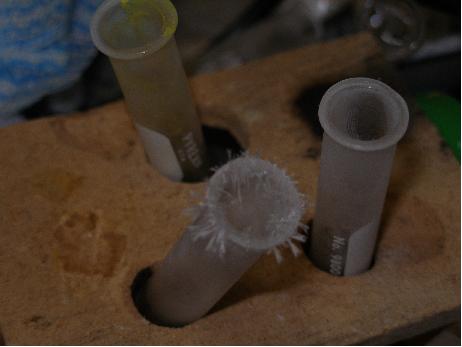
The_Davster - 6-5-2006 at 19:52
Several months ago when I got my V2O5, I did a few experiments with it. One consisted of adding a small ammount of V2O5 to some concentrated nitric.
From what I had read it would not react, and at the time it seemed like it did not. For some reason I set the testtube to the side with this in it
and left it for several months and forgot about it. I came across it today and crystals had grown on the mouth of the testtube. Anyone have any
thoughts on what these could be? I was thinking something like vanadyl nitrate, but I have been unable to find data on such a chemical.
[Edited on 7-5-2006 by rogue chemist]
[Edited on 7-5-2006 by rogue chemist]

chemoleo - 6-5-2006 at 20:24
How about the HNO3 slowly evaporated and reacted with volatile base in the air, which most likely is NH3, this being in a lab?? I often find precisely
this on bottles containing strong volatile acids...
12AX7 - 6-5-2006 at 21:03
But is it dry enough for ammonium nitrate *crystals*?
Neet lookin'...
If it were a vanadium compound, it would be colored though, no?
Tim
[Edited on 5-7-2006 by 12AX7]
The_Davster - 6-5-2006 at 21:20
On hydrochloric acid bottles I always find a whitish coating on them, as well as on everything if I ever leave any out. Never for nitric before
though, or perhaps I never left enough out before as it is precious... It has also always been a powder with HCl, never crystals.
I don't think there is much ammonia in the air, I have been out of the concentrated stuff for almost a year now, it is not high on my priority list,
and I don't even have a bottle of household ammonia around. And I cannot think of any volatile bases other than a very small ammount of hexamine, and
that is in a bottle under the counter, this tube was left on top of the counter.
There has been a reaction between the nitric and V2O5 as the solution above the V2O5 is light blue. Unless I spilled something in there or something,
but that is not likely.
unionised - 7-5-2006 at 00:33
There is generally some ammonia in the air from natural sources, even if you are not near a lab.
I can't easily imagine it's a vanadium compound. But, if you were to mix it with some nitric acid and heat it to, say, dull red heat, you ought to
convert any V to the oxide which would be involatile.
ordenblitz - 7-5-2006 at 08:11
I see this exact thing on my nitric acid bottles if they sit in the acid cabinet, untouched for a few weeks. I always wondered why this happened, but
never bothered to collect the crystals and analyze them.
I do keep aqua ammonia near by in an adjacent cabinet.
DeAdFX - 7-5-2006 at 09:17
My bottle of nitric acid does not show any sorts of crystals... It is stored in a 500mL flask with a glass stopper. I have had the acid for atleast
a year now. The only base I have stored near by is ~2lbs of hexamine.
woelen - 8-5-2006 at 04:05
I'm quite sure these crystals contain ammonium ions. I know this phenomenon very well from nitric acid and hydrochloric acid. Try to collect all these
crystals in a small test tube or in a plastic little spoon and add a few granules of solid wetted NaOH to them and then smell them. I once did with
similar crystals and I obtained the smell of NH3, unmistakenly. SO, I expect your crystals to be NH4NO3.
The V2O5 is slightly soluble in aqueous solutions and it also is not the most stable in solution. I can perfectly imagine that reduction, due to dust,
organic matter from the air, causes the shift to blue vanadyl (IV). The vanadyl ion VO(2+) is deep and very bright blue.
